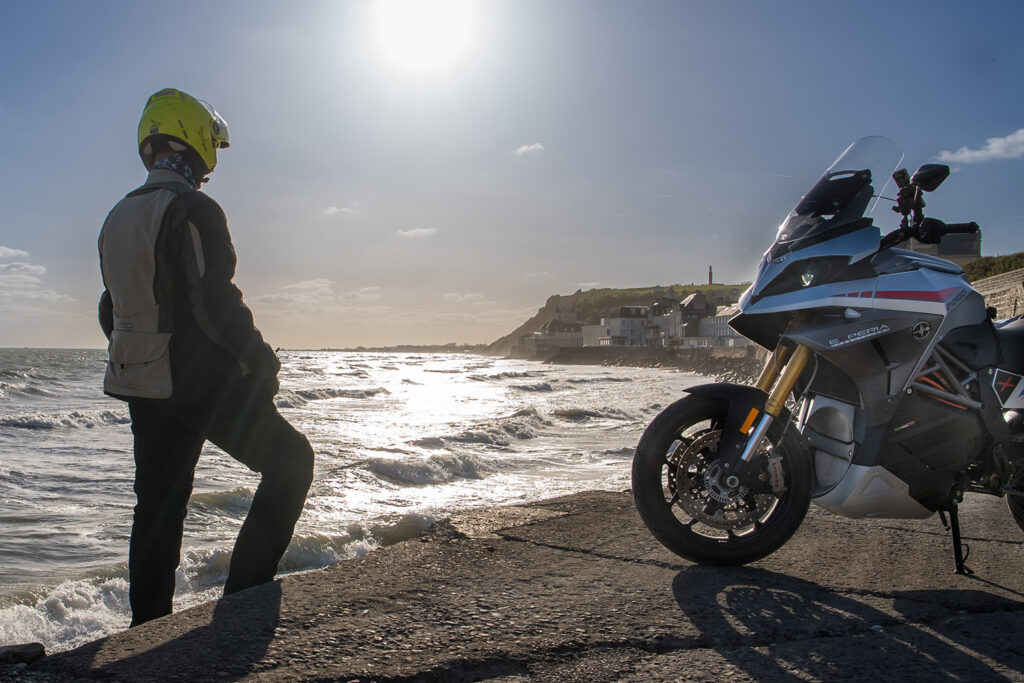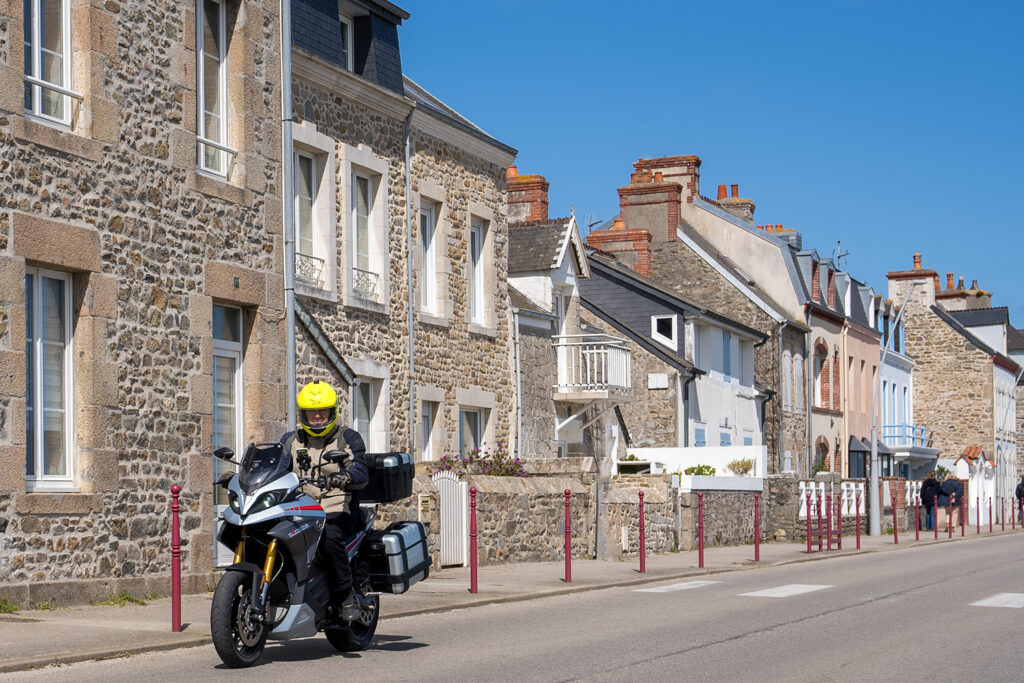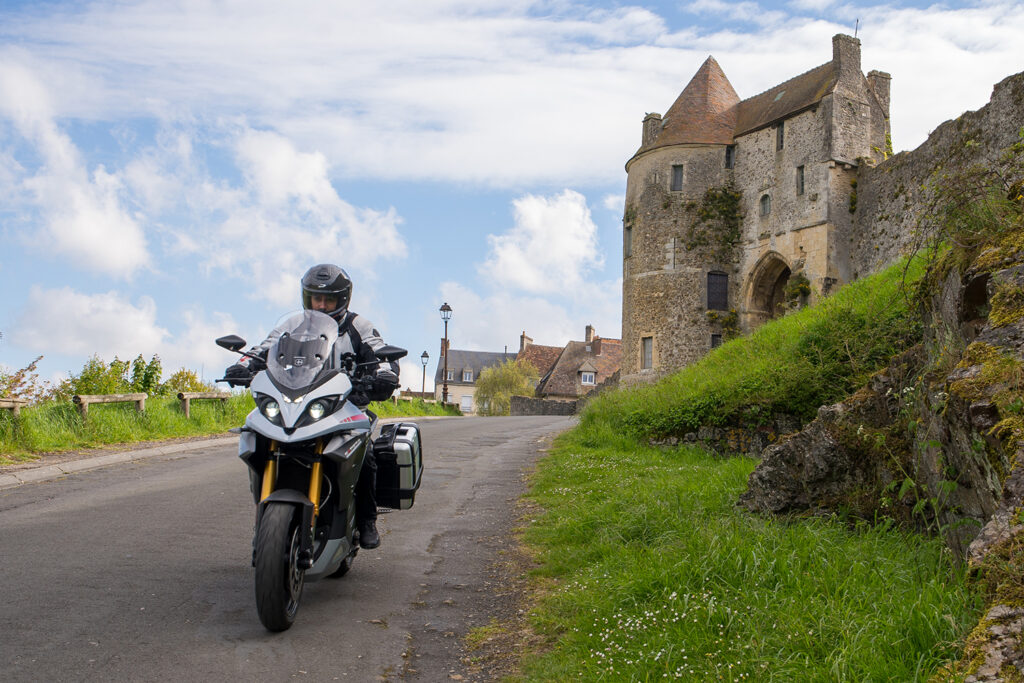Text by Marco Ghezzi | Photos by Matteo Maraglino & Matteo Cantatore | This publication is a collab between Marco Ghezzi, an Italian journalist focused on motorcycle tourism and promoting electric mobility through the eV-Now! Foundation and THE PACK. A journey through historical events and thrilling active tourism experiences to discover some of the most renowned places, as well as lesser-known ones in Normandy.


As the wheels of our electric fat bikes race across an endless expanse of golden sand, pounded by a relentless sea, I can’t help but think that right here one of the most brutal and tragic battles in contemporary history took place. We’re at Omaha Beach, and this shore, like many others along the Normandy coast, was the stage for the famous D-Day, the Allied invasion that marked the beginning of the end of World War II. These places, with their immense historical significance, – the 80th anniversary of D-Day was recently commemorated here – make you stop and reflect.


However, alongside the powerful memory of the past, these locations now offer engaging active tourism experiences. We’re eager to explore them in a different way, more dynamic and stimulating, that, while respecting their solemnity, offers a renewed image of this region. Here we are, pedaling along with Gilles, our guide, who, with great passion and enthusiasm, explains the stages of the landing, taking us to the most significant spots on Omaha Beach, from bunkers to trenches, even showing us the remains of an amphibious vehicle recently unearthed from the sands. Touching this relic from the past, our thoughts turn to the thousands of men who sacrificed their lives here so we could live in a freer world. Not far away Utah Beach, the first to be stormed by the Allies, is another iconic site of that June 6, 1944, when 23,000 soldiers landed.


Here too, while we can immerse ourselves in history at the large museum overlooking the sea or in front of the many commemorative monuments and moving memorials, we’re also ready for a new adrenaline experience, challenging the beach aboard car sailings. Steering these small sailboats on wheels takes a bit of practice, but once you get the hang of it, it’s pure fun to race, drift, chase each other, and sometimes even flip over, powered only by the wind!
The same wind that brushes against us as while our journey continues aboard two exceptional vehicles. In addition to honoring history, we also want to be respectful of the solemn atmosphere and the preserved nature of these places, visiting them almost “on tiptoe.” That’s why we opted for electric motorcycles, an EsseEsse9 RS and an Experia from Energica, both perfectly suited for touring.



These motorbikes are not only eco-friendly but also move quietly, allowing us to experience firsthand the real potential of taking a medium-to-long distance trip by electric mobility. After all, this is a new way of traveling on two wheels, still in its early stages in some respects, but with the potential to become an exciting adventure, especially for the motorcyclists of a new era. Normandy has proven to be ideal for an electric road trip, and it’s a true pleasure to find ourselves leisurely wandering, following the numerous winding, solitary roads that weave through the countryside, accompanied only by the sound of the wind.

As the roads of the Cotentin Peninsula, for example, which stretch from the bucolic landscapes of the inland to the wind-swept coast, passing through picturesque fishing villages, where the genuine rhythm of daily life still flows. Saint-Vaast-la-Hougue is one such village, welcoming us with the lively atmosphere of its renowned market, where the “petit paniers,” local small-scale producers, offer fresh seafood and seasonal goods. The stalls are brimming with oysters, scallops, a mouth-watering array of cheeses -including the ever-present Camembert – and many other regional specialties, creating a true feast of Norman flavors.

Continuing along the coast, we reach the huge beach of Jonville. This stretch of shoreline, where the tide can retreat for hundreds of meters, is an ideal spot for a relaxing walk or simply stopping to gaze at the ocean, soaking in that sense of vastness and freedom that these spaces with their infinite horizons so effortlessly evoke.


History takes center stage again when we arrive in Arromanches, a town famous for the artificial harbor used during the D-Day landings. At the evocative D-Day Museum, a lot of models, photos, and archival videos showcase the phases of constructing this remarkable feat. But what leaves the strongest impression are the remnants of the landing platforms, known as Mulberry Harbour, which still stand today as silent witnesses to a monumental undertaking. Our kayaks are already waiting on the shore, and for another adrenaline-filled adventure, we set out to explore these metal giants from the sea. The water-level perspective offers a unique and evocative view, making it easy to imagine the constant flow of troops and materials that passed through here during those crucial days.


Beyond its historical significance, Arromanches has much more to offer. Its relaxed and welcoming atmosphere, the charming Norman houses with their stone facades and slate roofs, the lovely seaside promenade, and the small cafés and restaurants where you can enjoy delicious seafood dishes and sip on a good Calvados (the famous Norman apple brandy) make it a truly delightful town. The most enchanting moment, however, comes once again on our bikes. With just a touch of throttle, we follow the road that winds up to the Royal Memorial promontory, one of the best spots to take in the panoramic view of this stretch of coast. In front of us, the sunset paints the cliffs in countless shades of red and orange while the sun disappears over the horizon.


Beyond the beaches and historical memories, however, there is another Normandy waiting to be discovered, that of the inland. The locals call it “La Suisse Normande,” for its rolling green hills, dense forests, and picturesque villages that paint a completely different landscape from the coast. We realize this as we follow the winding roads through a scene that feels like it’s straight out of an Impressionist painting. The discreet hum of our electric bikes makes us feel even more immersed in the tranquility and beauty of these places, adding a touch of magic to our journey.


Le Hom is a small village that seems frozen in time. Nestled between the hills and the Orne River, it retains an authentic rural architecture and a slow pace of life. Here, the waters of the Orne flow gently, perfect for a relaxed paddle; the canoes lined up along the banks beckon us, and we’re quick to trade our saddles for paddles, ready to enjoy another delightful excursion. The picturesque village of Clécy, known as the “capital” of Norman Switzerland, embodies even more the charm and beauty of the French countryside, offering a perfect blend of history and outdoor adventure. Just outside the village, a trail leads to the Rochers des Parcs, a natural area marked by towering cliffs overlooking the Orne River. The climb, though short, requires some effort, but in the end, we’re rewarded for making the trek. From the top of a rock overlooking the valley, we can take in a breathtaking natural panorama.




The winding and thrilling Route des Crêtes runs high along the hills, leading us to Rochers de la Houle, the most spectacular viewpoint in Norman Switzerland, and finally to Falaise, famous as the birthplace of William the Conqueror. The town, still enclosed by mighty walls, with its cobblestone streets and half-timbered houses, preserves its medieval soul. William’s castle, perched atop a hill, dominates the landscape, and visiting it is like stepping back in time, through medieval rooms and massive walls that tell the story of the Norman who became King of England.



In the nearby square named after him, we come across “War is Hell,” a unique artwork in France, created by Jef Aérosol, a pioneering French street artist. He has adorned a real Sherman tank with dozens of images of men, women, and children. It’s a tribute to the civilians and soldiers who were victims of conflicts, a message of peace, and a symbol of a Normandy that remembers its past but also seeks to give history a new face.

Traveling Electric
Normandy is well-organized in terms of electric mobility, with charging stations, particularly AC ones, distributed across the region. Fast DC charging stations are available in all major towns along the coast, but somewhat less so in the inland areas. We found DC charging stations in Caen, Bayeux, Carentan, Valognes, often located near shopping centers. A useful app for finding these stations is Nextcharge, which also allows preloading the card for payments.

General information
Where to sleep and eat:
Les Villas d’Arromanches
A charming and very comfortable hotel, located just steps away from the historic center of Arromanches, it can serve as an excellent “base camp” for excursions along the coast. The hotel offers AC charging stations for electric vehicles.
Les Villas d’Arromanches
Restaurant La Marine – Arromanches
Located in a beautiful spot along the Arromanches seaside promenade, this restaurant offers particularly tasty seafood dishes.
Restaurant La Marine
Restaurant Au 6 juin – Arromanches
A lovely brasserie with an informal atmosphere, serving a variety of local cuisine dishes.
Restaurant Au 6 juin
Active tourism activities
For e-bike excursions and car sailing on Omaha Beach:
Base EOLIA de Colleville-sur-Mer
For kayaking to discover the Arromanches landing pontoons:
Centre de Loisirs Nautiques d’Asnelles
Official site:
https://en.normandie-tourisme.fr/